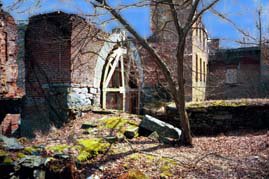
I took Georgia History in the 8th grade. I saw Gone With the Wind. I know about the War Between the States and Abraham Lincoln and the freeing of the slaves. I know about General Sherman's march to the sea and the path of destruction he left in his wake. I don't fly the Confederate Rebel flag (like a lot of Southerners still do), I am glad we are a nation united and the slaves are free.
When driving through Atlanta, there is no evidence of the fires and destruction, all is new and shiny and rebuilt. And traveling south of Atlanta on Tara Boulevard, all is fine, shopping centers and housing developments, no ravaged plantations.
I don't hold any grudges against the Yankees, it was over 140 years ago, all just a story in the history books or at the movies…
Until we visited Sweetwater Creek State Park a couple of summers ago. We just wanted to see the place where Buddy's dad had played as a young boy with his brothers and sisters, see the remains of the old factory he spoke of, and the shoals in the creek near his home west of Atlanta.
We stopped at the visitor's center, picked up some info on the park, and headed out down the trail to the creek.
Our first reaction to the sight of Sweetwater Creek was surprise, this was more like a river, wide and quickly flowing by over a very visible straight line of rocks, the Brevard Fault line running through this part of Georgia.
We soon came upon the shell of a 5-story brick building sitting right on the bank of the water. We started reading the info to see what this building used to be, and that is when all the stories in the history books came to life.
Clay from the lowland areas of Sweetwater Creek was used by slaves in manufacturing the thousands of bricks to be used in the construction of the tallest building in Georgia at the time, the cotton mill known as the Sweetwater Manufacturing Company.
The textile mill started production in 1849, and by 1862, the Confederacy was purchasing all the cotton cloth the mill could supply for uniforms, tents, sheets, etc.
Since the mill was so important to the Confederacy, its destruction became inevitable as Union forces under General Sherman advanced. The male factory workers had joined the army, leaving mostly women in the mill.
The mill was running at full force at 10:00 AM on July 2, 1864, when Union Cavalry arrived. General Sherman’s orders were to “burn the mills and arrest all the women, no matter what the clamor.” Large cans of kerosene were carried to each of the five floors of the mill and each floor saturated, the mill was then torched.
The mill workers and their families, about four hundred women and children, were taken as prisoners of war, herded into railcars and shipped north of the Mason/Dixon Line to work in Northern factories.
After the war, destitute and separated from family members, many of the cotton mill workers were unable to return home. Some returned only to find their homes burned, ransacked, and ravaged by war. Others chose to rebuild their lives north of the Ohio River.
What started out as a Sunday afternoon diversion ended up in an enlightening history lesson. All the stories in schoolbooks and images in movies was nothing compared to standing looking in person at Sherman's destruction. It doesn't take much imagination to smell the smoke or see the reflection of flames in the rushing water. One can certainly understand the origin of the term - damn Yankees!
Mill Ruins Today



